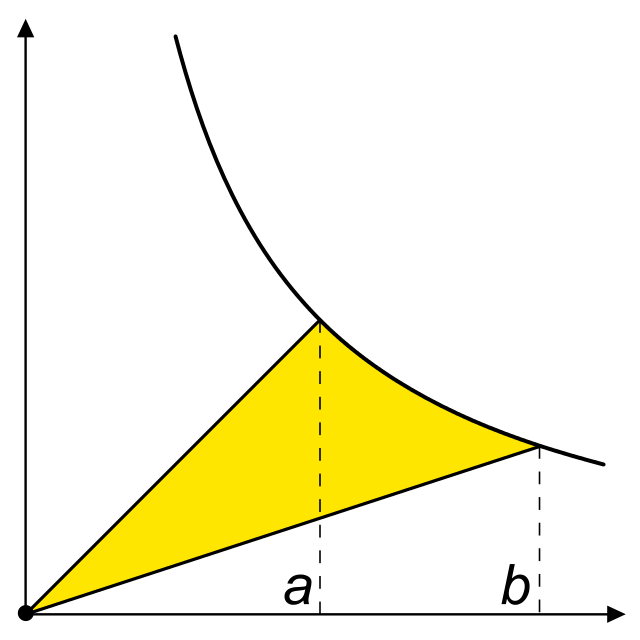热门问题
时间线
聊天
视角
快度
来自维基百科,自由的百科全书
Remove ads
在相對論中,快度通常被用來衡量相對論效應下的速度。在數學上,快度可以被定義成一個雙曲角,這個角能夠反映兩個存在相對運動的參考座標系之间的差异——它们的时空坐標为洛仑兹变换所聯繫。
對於一維運動,快度可以簡單相加,而速度必須套用愛因斯坦的速度加成式。在低速的情況下,快度和速度是成比例的,但是對於更高速的狀況下,快度將增長得更快。特别地,光的速度為光速,而光的快度是無限大。
我們使用反雙曲函數artanh來定義快度,當速度為v時,其對應的快度w是w = artanh(v / c),其中c是光速。速度較慢時,w約為v / c。由於在相對論中,速度v被局限於區間−c < v < c,因此比率v / c將滿足−1 < v / c < 1。反雙曲正切函數的定義域為(−1, 1),而值域為整條實數線,所以可以將區間−c < v < c映射到−∞ < w < ∞。
Remove ads
歷史

在1908年赫爾曼·閔考斯基指出勞倫茲轉換可以被簡單的轉換為座標時中的雙曲旋轉,即為一個虛數角度的旋轉。[1] 這個角度在一維空間中可以代表著座標系間速度的度量,且具有可加性。[2]
1910年,弗拉基米爾·瓦里卡克[3]和E. T. 惠特克[4]提出用此參數來取代速度的觀念。而這個參數被阿爾弗雷德·羅伯 (1911)[5]命名為快度,並隨後被許多筆者所採用,如盧迪威格·席柏斯坦 (1914),愛德華·莫立 (1936)和沃夫岡·潤德勒 (2001)。
雙曲函數xy=1的求積法,是由格雷瓜爾·德·聖-文森特提出的,他指出雙曲扇形的面積、或是一塊沿著漸進線所定義出的等效面積,可以用自然對數描述。 在時空理論中,類光事件將宇宙分為相對於給定“位置”和“時刻”的“(絕對)過去”、“(絕對)未來”和其他時空點。在空間中的任何一條線上,一道光束的行進方向可以向左或是向右。將向右行進的光束事件定為x軸,向左行進的光束事件定為y軸。則靜止座標系的時間軸即為對角線x = y。而速度可以用第一象限中的直角雙曲線xy = 1來表示,其中速度為零的點對應到點。任何一個雙曲線上的點都能以點 表示,其中的w即為快度,同時w也是從點 到點與原點所構成的雙曲線扇形面積。 也有許多筆者在討論標準閔考斯基圖時,會使用單位雙曲線,將快度作為參數曲線的參數。而此時的坐標可以用時鐘和米尺來測量,並選用更加常見的基準,這也是時空理論的基礎。所以快度作為光束空間的雙曲參數,這樣的描述是參考了十七世紀時超越函數理論的發展,以及閔考斯基圖。
Remove ads
在一維空間中
快度w出現在勞倫茲變換的線性表示法中,此時勞倫茲變換被表示為向量-矩陣乘積
矩陣Λ(w)為的形式,其中p和q滿足關係p2 - q2 = 1,因此(p, q)將會落在單位雙曲線上。這樣的矩陣形成了不定正交群 O(1,1),伴隨著由單位反對角矩陣所張出的一維李代數,顯示出快度是這個李代數上的座標,這個作用可在閔考斯基圖上被描繪出來。 在矩陣指數表示法中,Λ(w)可以被表示為,其中Z是矩陣
不難證明
這顯現出了快度實用的求和性質:若A,B和 C為參考座標系,則
其中 wPQ 表示了參考座標系Q相對於參考座標系P的快度。與速度加成式相比,這個式子更為簡潔。
我們可以從上述的勞倫茲轉換看出,勞倫茲因子等同於cosh w
因此快度w作為一個雙曲角,隱含在勞倫茲轉換中的γ和β中。我們將快度與速度加成式聯繫在一起
藉由
從而得到
β和γ的乘積時常出現,從先前的討論可知
固有加速度(一個加速物體實質感受到的加速度)是快度對於固有時間(一個加速物體本身所量測到的時間)的變化率。假想在物體的運動過程中,與加速中的物體保持相對靜止的一系列“非物理的”參考系,若在這個非物理的慣性系中非相對論性地計算物體的速度,則計算結果將是這個物體的快度。
Remove ads
由上述的表達式可以得到
因此
或是更加清楚地表示為
相對論性都普勒效應因子與快度w的關係為。
Remove ads
在多維空間中
相對論性速度與快度为下列關係所聯繫[6]
其中的向量是勞侖茲群對應的李代數中,由三個推進生成元張成的三維線性子空間上的座標。而這可以完全類比至上述一維情況時的。因為光速是速度量值的上限(選用單位使得),所以速度符合條件,因此速度空間可以用一個半徑為的開球表示。
其中對應到速度加成式,是方向上的單位向量。這個運算不符合交換律與結合律。斜向角度為的快度之和的模(歐氏空間中的長度)由餘弦的雙曲關係給出[8]
快度空間上的幾何結構,透過對應的映射繼承了速度空間上的雙曲幾何。相應地,這個幾何結構可以從相對論性速度的求和公式來推得。[9]因此,二維空間中的快度空間可以有效地透過龐加萊圓盤模型來想像[7],其上的測地線會對應到勻加速運動。三維空間中的快度空間,可以透過同樣的方法,與雙曲面模型建立保距同構。閔考斯基時空的幾何條目中有更多相關的細節。
兩個快度的相加變換並非只是獲得一個新的快度值,整體的變換是由上述求和式給出的快度、透過向量來參數化的旋轉,兩者組合而成。
這裡使用到了物理學家慣用的指數映射。 這是交換法則所致的結果
Remove ads
在粒子物理中
一個非零(靜止)質量m粒子的能量E以及動量的大小|p| 為:
透過快度w的定義
並且
能量和動量大小可以被表示為
所以快度可以用測量到的能量與動量大小透過下式來計算得出:
然而實驗粒子物理學家常使用修改過的、相對於粒子束的快度定義
其中pz是沿著粒子束方向的動量分量[10]。這是從「實驗室參考系」到一個「粒子運動方向與粒子束方向垂直的參考系」的勞倫茲變換所對應的快度,相關的概念可以參考條目贗快度。
Remove ads
參見
注釋
參考文獻
Wikiwand - on
Seamless Wikipedia browsing. On steroids.
Remove ads
















![{\displaystyle w=\ln \left[\gamma (1+\beta )\right]=-\ln \left[\gamma (1-\beta )\right]\,}](http://wikimedia.org/api/rest_v1/media/math/render/svg/e880a524c2540a67539b1dc6e477ba9dc7059002)





















![{\displaystyle [K_{i},K_{j}]=-i\epsilon _{ijk}J_{k}}](http://wikimedia.org/api/rest_v1/media/math/render/svg/8049ea97a76dcb266ab9baad829357561e4a0718)










